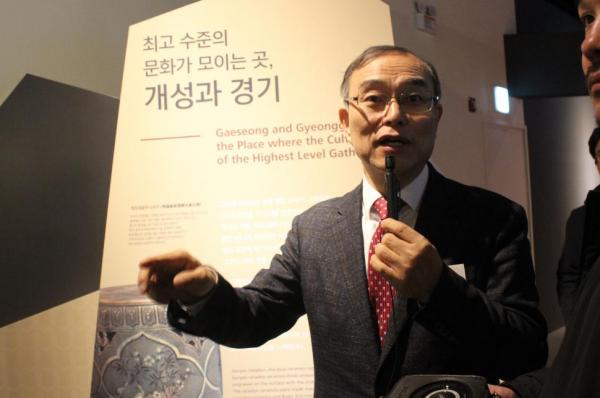
DAEGWALLYEONG, South Korea, Feb. 10 (UPI) — Hours before the opening ceremony of the 2018 Pyeongchang Winter Olympics, a South Korean historian who excavated ancient artifacts in North Korea had an announcement: a joint North-South exhibit.
“The unification ministry has offered to co-host, and North and South agreed to talk about the matter after the Olympics,” said Ahn Byung-woo on Friday at the opening ceremony for a special exhibit on palace relics dating back to the medieval Goryeo dynasty.
The news of a potential joint exhibit has been overshadowed by bigger developments: the arrival of North Korean leader Kim Jong Un‘s sister in the South, and her handshake with South Korean President Moon Jae-in.
For reasons that are not difficult to fathom, Seoul’s decision to invite Kim Yo Jong and the North Korean delegation has angered South Korean conservatives.
Outside the exhibit in Daegwallyeong on Friday, angry right-wing activists bearing the South Korean and American flags called for the removal of Moon from office for turning the Pyeongchang Olympics into the “Pyongyang Olympics.”
Historians like the soft-spoken Ahn, however, are taking a different approach, and Ahn and South Korean activists who have supported détente with the belligerent North think evoking the shared past of a divided people can bring them together.
The decade-long project to dig up the ruins of Manwoldae, a 10th-century palace complex, is one of the rare instances of civic exchange that has persisted despite Pyongyang’s missile tests.
But it could also be being used as a tool by the South Korean government to gain the confidence of the North, while persuading a confused South Korean public the Kim Jong Un regime is more than a proliferator of weapons of mass destruction.
In a video message delivered to the exhibit organizers on Friday, Seoul’s Unification Minister Cho Myung-gyun said the “government actively supports the exhibit…so that we may pass our heritage on to the next generation.”
The display of replica which opens to the public on Saturday, also betrays an undercurrent in South Korea — reconciliation with the North, without the full cooperation of Pyongyang.
The North Korean authorities who permitted the South Koreans to dig at Kaesong also banned them from borrowing the original artifacts that include roof tiles and recovered vases.
In their absence, South Korea turned to state-of-the-art technology to stage the exhibit.
“Because we could not bring the actual artifacts, we can only see it in holograms and 3D,” said Ahn. “We hope to see the excavated artifacts in Kaesong.”
While the North Koreans Ahn worked with in Kaesong declined to attend the South Korean ceremony, they may be taking the excavation seriously.
Ahn told UPI there is a “greater emphasis” on the history of the Goryeo period in the North than in the South, where a previous dynasty, Shilla, is believed to have been the first kingdom to unify most of the peninsula.
“Goryeo is the predecessor to North Korea,” in geographical terms, Ahn said.
Ahn also said North Korea is not opposed to the idea of South Korea taking on more projects in the areas of preservation and museums.
There had been plans of creating a jointly held exhibition space in the Kaesong Industrial Complex, but “it did not move forward because of the shuttering of the factories” in 2016, Ahn said.
The excavation, launched in 2007, was a gamble for Ahn and the South Korean team.
“We dug without knowing whether we would come up with anything,” he said.
But over the course of a decade, the team, using shovels and South Korean Hyundai tractors, uncovered several key features of Manwoldae, including staircases and drainage canals that surround the structures.
“It’s unclear whether the palace rose one or two stories,” the historian said.
Ahn added he plans to return to North Korea to continue the project, possibly using the same route he took on previous trips.
“When I drove the car over the yellow line, tears came to my eyes,” he said. “It’s different when you’re driving, than when you’re being transported by bus.”






